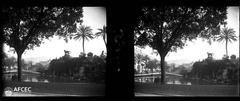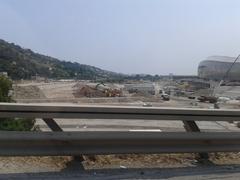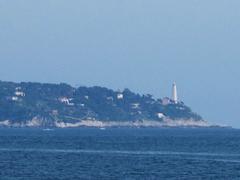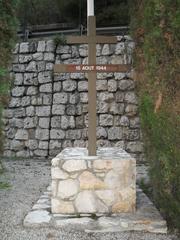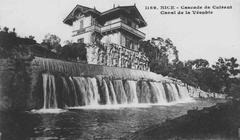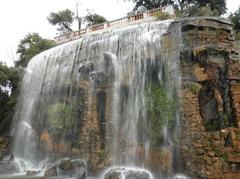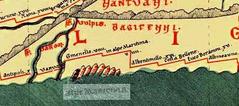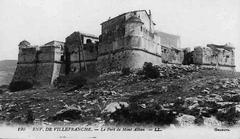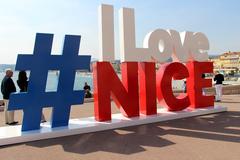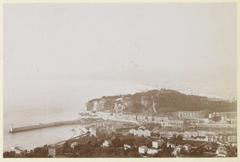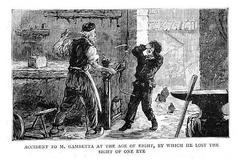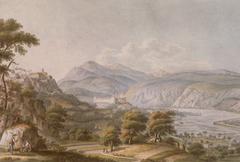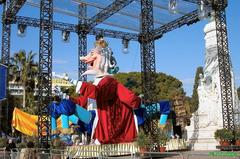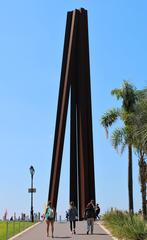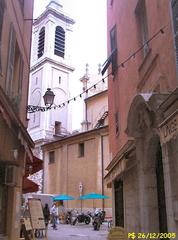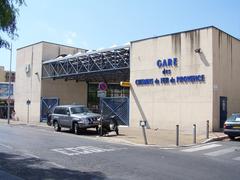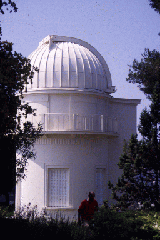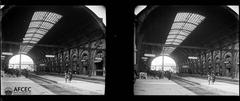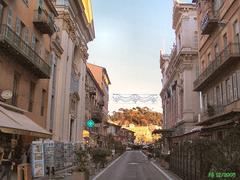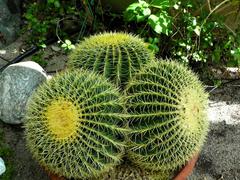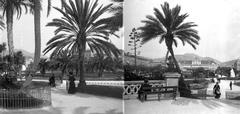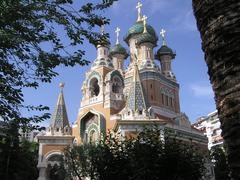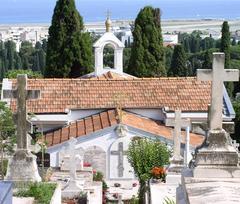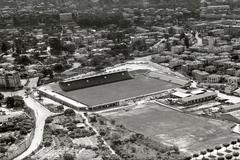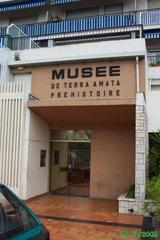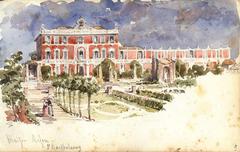Musée International d’Art Naïf Anatole Jakovsky: Complete Guide to Visiting Hours, Tickets, and Nice’s Naïve Art Heritage
Date: 04/07/2025
Introduction
Nestled within the elegant Château Sainte-Hélène in Nice, France, the Musée International d’Art Naïf Anatole Jakovsky stands as a one-of-a-kind institution dedicated to the celebration and preservation of naïve art. This unique museum offers an immersive journey through the imaginative creations of self-taught artists from around the world, set against the backdrop of a historic Belle Époque villa. Whether you are an art enthusiast, a family seeking creative workshops, or a traveler exploring Nice’s cultural heritage, this comprehensive guide provides all the details you need—visiting hours, ticketing, accessibility, and nearby attractions—to make the most of your visit (Nice Premium; SeeNice.com).
Table of Contents
- Museum Overview and Significance
- Origins and Historical Context
- Collection and Notable Artists
- Evolution and Recent Renovations
- Exhibitions: Permanent, Temporary, and Outdoor
- Visitor Information
- Community Engagement and Educational Outreach
- FAQs
- Summary and Visitor Tips
- References and Further Reading
Museum Overview and Significance
The Musée International d’Art Naïf Anatole Jakovsky is a global reference point for naïve art—a genre defined by vivid colors, imaginative perspectives, and a disregard for academic conventions. The museum’s setting in the historic Château Sainte-Hélène (once owned by perfumer François Coty) offers visitors a unique blend of architectural grandeur and artistic whimsy (Nice Premium; SeeNice.com). Since its opening in 1982, the museum has grown to house more than 1,000 works by over 300 artists from 40+ countries, making it one of the world’s most significant naïve art collections (WhichMuseum; Nice Tourism).
Origins and Historical Context
Founded through the passion and advocacy of Anatole Jakovsky and his wife Renée, the museum’s permanent collection began with their donation of over 600 artworks. Jakovsky, a renowned art critic and collector, sought to create a space where naïve art could be appreciated on its own terms. The Château Sainte-Hélène, a Belle Époque landmark, provides the perfect setting, reflecting early 20th-century opulence and Nice’s rich artistic legacy (Wikipedia; Nice Premium).
Naïve art itself traces its roots to the 18th century, gaining recognition in the late 19th and 20th centuries through artists like Henri Rousseau, whose dreamlike, technically unorthodox paintings paved the way for generations of self-taught artists (SeeNice.com).
Collection and Notable Artists
Diversity and Scope
The museum’s collection is both international and multidisciplinary, featuring paintings, sculptures, drawings, and posters by artists from more than 27 countries. The breadth of the collection underscores the universal appeal and accessibility of naïve art, often created outside formal art circles (WhichMuseum; Provence Lovers).
Notable Artists and Highlights
- Henri Rousseau (“Le Douanier Rousseau”): Iconic dreamlike landscapes.
- Séraphine Louis (Séraphine de Senlis): Mystical, nature-inspired works.
- Grandma Moses: American folk art legend.
- Ivan and Josip Generalić: Pioneers of the Croatian naïve school.
- Antonio Ligabue: Italian artist noted for expressive animal portraits.
- Frédéric Lanovsky: Playful outdoor sculptures in the museum gardens.
The collection also features important outsider art (art brut) and singular art, including works by Gaston Chaissac and Danielle Jacqui (Explore Nice Côte d’Azur).
Evolution and Recent Renovations
A major renovation between June 2024 and January 2025 transformed the museum, improving accessibility and enhancing the visitor experience (Nice Premium). Key improvements include:
- Exterior Elevator: Full access for visitors with reduced mobility.
- Redesigned Entrances, Shop, and Restrooms: Improved navigation and comfort.
- Optimized Circulation: New staircase placement for better visitor flow.
- Renovated Animation Rooms: Welcoming spaces for workshops and family activities.
The exhibition spaces now feature thematic galleries—such as the Sea Room, inspired by Danielle Jacqui—highlighting both the distinctions and connections among naïve, brut, and singular art. Temporary exhibitions and educational programming keep the museum vibrant and relevant (Nice Premium).
Exhibitions: Permanent, Temporary, and Outdoor
Permanent Collection
Spanning from the 18th to 21st centuries, the permanent collection is arranged thematically and chronologically, inviting visitors to trace the evolution of naïve art and related genres. Themes include landscapes, everyday life, animals, nature, innocence, and humor (RecreaNice; France Voyage).
Temporary Exhibitions
The museum hosts several temporary exhibitions each year, exploring new themes and spotlighting contemporary naïve and outsider artists. Past highlights include “Pièces à Conviction,” “#enlargeyourlife,” and the 40th Anniversary Exhibition (Nice Riviera). Check the museum’s events page for current programming.
Outdoor Installations and Gardens
The museum’s lush park is home to rare Mediterranean flora and Frédéric Lanovsky’s giant, colorful sculptures. The gardens serve as an open-air museum, with accessible paths, benches, and a living herbarium inspired by the art on display. Picnicking is permitted in designated areas (Provence Lovers).
Visitor Information
Visiting Hours
- Tuesday to Sunday: 10:00 AM – 6:00 PM
- Closed: Mondays, January 1st, Easter Sunday, May 1st, and December 25th (Ville de Nice)
Tickets and Accessibility
- Adults: €10
- Reduced Rate (students, seniors, groups): €8
- Free: Children under 18, disabled visitors, and every first Sunday of the month
- Nice Museum Pass: Access to multiple municipal museums over 24 or 72 hours
- Purchase: Onsite or online
Accessibility: Ramps and elevators allow access to most exhibition areas. Wheelchairs available upon request. Contact the museum for detailed accessibility information (contact page).
Getting There
- Address: Château Sainte-Hélène, 23 Avenue de Fabron, 06200 Nice, France
- Public Transport: Tram line 2 (Fabron stop), Bus lines 12, 22
- Parking: Free on-site (limited spaces)
- Cycling: Bicycle racks at entrance
Facilities and Services
- Restrooms: Accessible on ground floor
- Gift Shop: Art books, postcards, and souvenirs
- Vending Machines: Drinks and snacks available
- Gardens: Benches, shaded areas, and picnic spots
- Wi-Fi: Free public access
- No On-Site Café: Nearby cafés and restaurants within a 10-minute walk
Community Engagement and Educational Outreach
The museum is deeply committed to community outreach through workshops, guided tours, and educational activities for all ages. Notably, during renovation, the “ateliers-buissonniers” brought art-making into the community, reaching residents in care homes, hospitals, and local facilities (Nice Premium). Regular family programs and collaborations with schools and local libraries foster creativity and inclusivity.
FAQs
Is the museum wheelchair accessible?
Yes. Most areas are accessible via ramps and elevators. Contact the museum for specific needs.
Are guided tours available?
Yes. French tours are scheduled regularly, and English-language tours can be arranged in advance.
Can I take photos?
Non-flash photography for personal use is allowed. Tripods and commercial photography require permission.
Can I buy tickets online?
Yes. Tickets are available at the entrance or online.
Is the museum family-friendly?
Absolutely. Interactive workshops and gardens are ideal for children.
Are there special rates?
Yes. Reduced rates are available for students, seniors, groups, and free entry for children under 18 and on the first Sunday of each month.
Summary and Visitor Tips
The Musée International d’Art Naïf Anatole Jakovsky offers an inspiring, accessible, and enriching experience for all visitors. Its internationally renowned collection, set within the historic Château Sainte-Hélène and surrounded by whimsical gardens, makes it a must-see cultural destination in Nice. Recent renovations have enhanced accessibility, while dynamic programming ensures that both newcomers and returning visitors will find something new to discover. Combine your visit with nearby attractions such as the Musée Matisse or the Promenade des Anglais for a full immersion in Nice’s vibrant cultural scene.
Plan ahead by checking opening hours and booking tickets online. Consider joining a guided tour for deeper insight, and enjoy the museum’s tranquil gardens for a unique blend of art and nature.
For the latest updates on exhibitions, events, and visitor information, visit the official museum website, and download the Audiala app for guided tours and exclusive content.
References and Further Reading
- Visiting the Musée International d’Art Naïf Anatole Jakovsky in Nice: Hours, Tickets, and What to Expect, 2025, Nice Premium (Nice Premium)
- Visiting the Musée International D’Art Naïf Anatole Jakovsky in Nice: Hours, Tickets, and History of Naïve Art, 2025, SeeNice.com (SeeNice.com)
- Musée International d’Art Naïf Anatole Jakovsky: Visiting Hours, Tickets, and Exploring Nice’s Historical Art Gem, 2025, Provence Lovers (Provence Lovers)
- Musée International d’Art Naïf Anatole Jakovsky in Nice: Visiting Hours, Tickets, and Visitor Guide, 2025, Ville de Nice (www.museejakovsky-nice.org)
- Musée International d’Art Naïf Anatole Jakovsky, Wikipedia (Wikipedia)
- Musée International d’Art Naïf Anatole Jakovsky, Nice Tourism (Nice Tourism)
- WhichMuseum: Musée International d’Art Naïf Anatole Jakovsky, 2025 (WhichMuseum)
